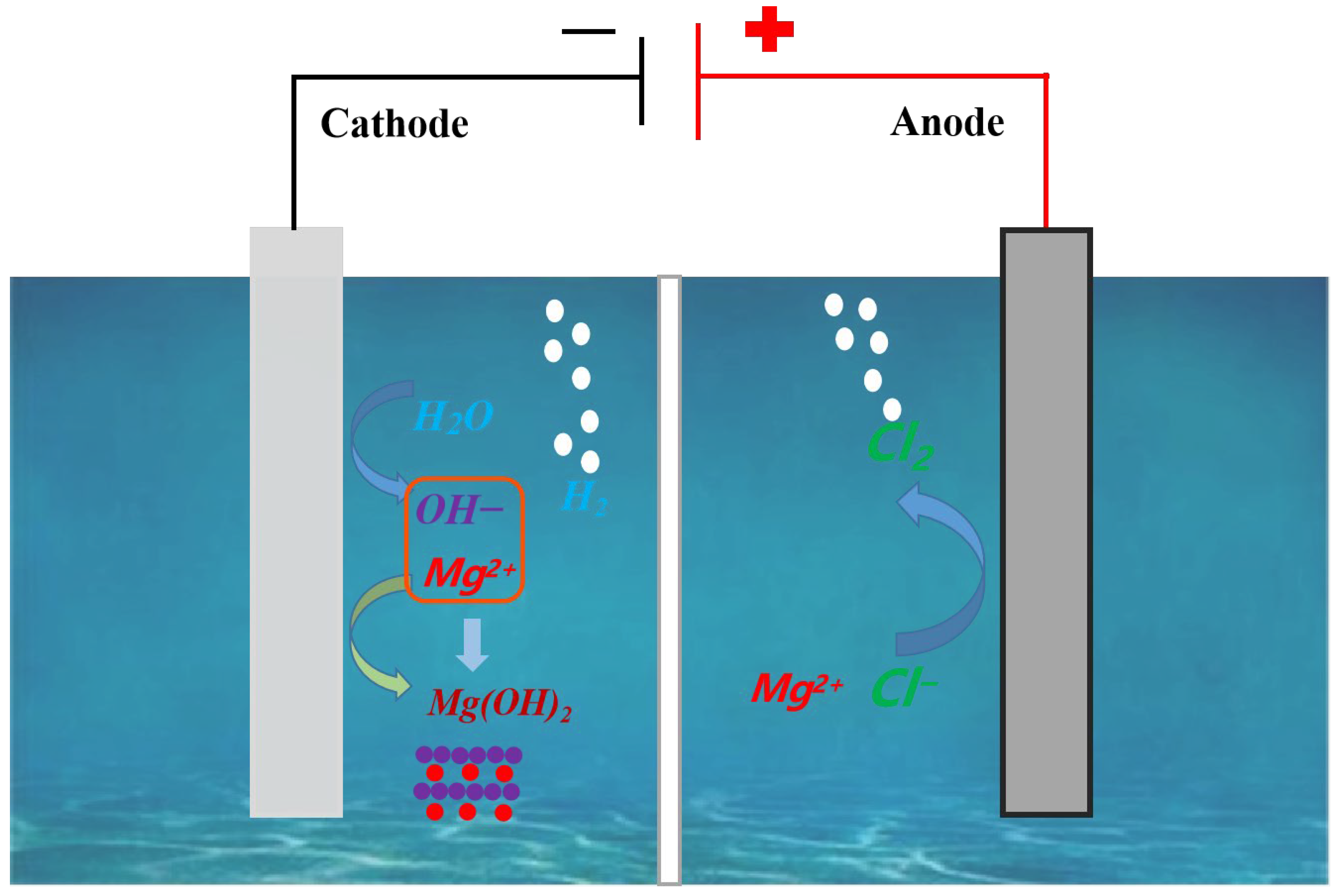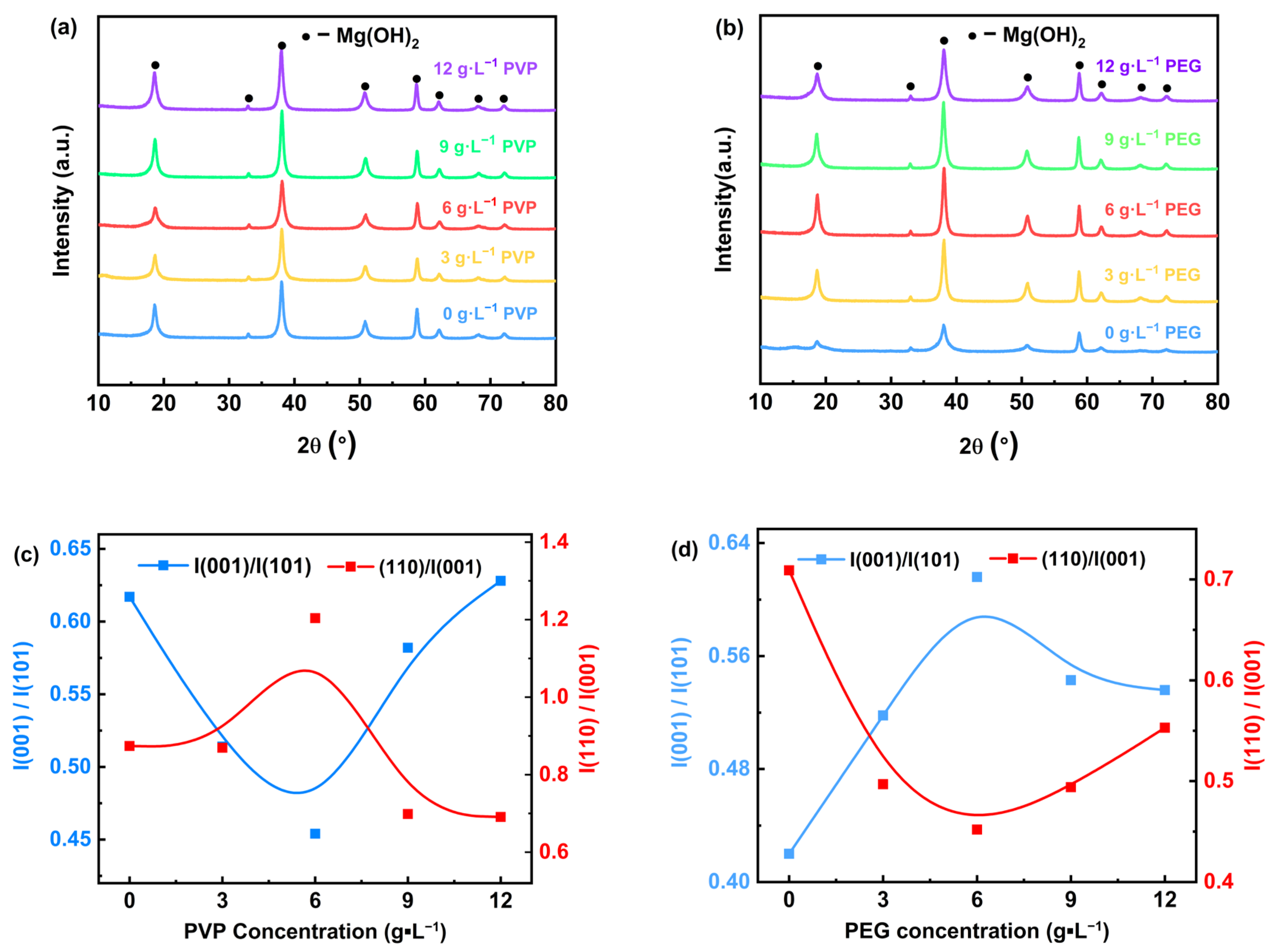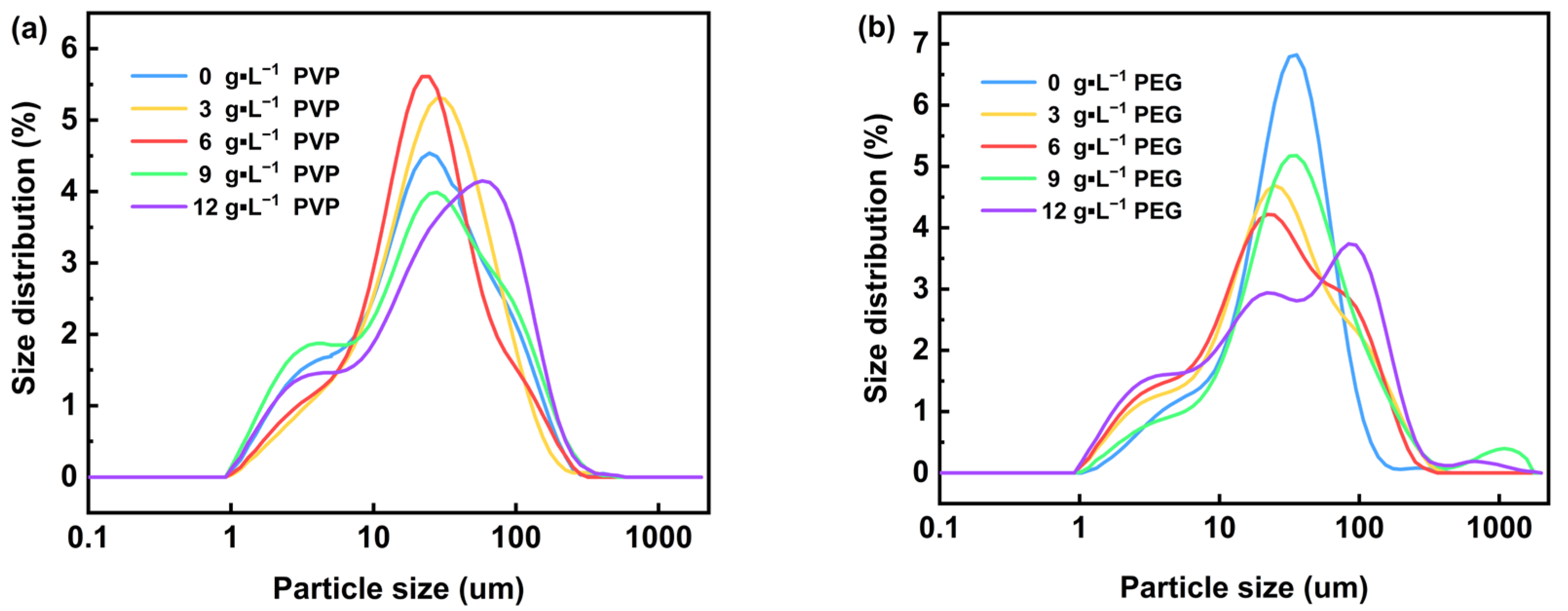Influence of PVP and PEG on the Electrochemical Synthesis of Magnesium Hydroxide
Abstract
1. Introduction
2. Materials and Methods
2.1. Materials
2.2. Experimental Method
2.3. Analytical Characterization
3. Results and Discussion
3.1. Effect of Surfactant Addition on Electrolytic Parameters
3.2. Effect of PVP on the Properties of Electrodeposition Product
3.3. Effect of PEG on the Properties of Electrodeposition Product
4. Conclusions
Author Contributions
Funding
Institutional Review Board Statement
Informed Consent Statement
Data Availability Statement
Conflicts of Interest
References
- Pilarska, A.A.; Klapiszewski, Ł.; Jesionowski, T. Recent development in the synthesis, modification and application of Mg(OH)2 and MgO: A review. Powder Technol. 2017, 319, 373–407. [Google Scholar] [CrossRef]
- Balducci, G.; Diaz, L.B.; Gregory, D.H. Recent progress in the synthesis of nanostructured magnesium hydroxide. CrystEngComm 2017, 19, 6067–6084. [Google Scholar] [CrossRef]
- Zhao, C.; Cao, F.; Song, G.-L. Corrosivity of haze constituents to pure Mg. J. Magnes. Alloys 2020, 8, 150–162. [Google Scholar] [CrossRef]
- Lu, Y.; Wu, C.; Xu, S. Mechanical, thermal and flame retardant properties of magnesium hydroxide filled poly(vinyl chloride) composites: The effect of filler shape. Compos. Part A Appl. Sci. Manuf. 2018, 113, 1–11. [Google Scholar] [CrossRef]
- Li, T.; Ichimura, M. Fabrication of Transparent Mg(OH)2 Thin Films by Drop-Dry Deposition. Materials 2021, 14, 724. [Google Scholar] [CrossRef]
- Keikhaei, M.; Ichimura, M. Fabrication of Mg(OH)2 thin films by electrochemical deposition with Cu catalyst. Thin Solid Film. 2019, 681, 41–46. [Google Scholar] [CrossRef]
- Gong, L.; Yao, Z.; Zhu, C.; Lian, X.; He, B.; Qu, L.; Xiong, W.; Yu, B. Synthesis of porous Mg(OH)2 nanowires for phosphate removal from water. Colloids Surf. A Physicochem. Eng. Asp. 2023, 676, 2–12. [Google Scholar] [CrossRef]
- Yan, H.; Bai, J.; Chen, X.; Wang, J.; Zhang, H.; Liu, Q.; Zhang, M.; Liu, L. High U(vi) adsorption capacity by mesoporous Mg(OH)2 deriving from MgO hydrolysis. RSC Adv. 2013, 3, 23278–23289. [Google Scholar] [CrossRef]
- Hanna, A.A.; Abdelmoaty, A.S.; Sherief, M.A. Synthesis, Characterization, and Thermal Behavior of Nanoparticles of Mg(OH)2 to Be Used as Flame Retardants. J. Chem. 2019, 2019, 1805280. [Google Scholar] [CrossRef]
- Alves, M.M.; Batista, C.; Mil-Homens, D.; Grenho, L.; Fernandes, M.H.; Santos, C.F. Enhanced antibacterial activity of Rosehip extract-functionalized Mg(OH)2 nanoparticles: An in vitro and in vivo study. Colloids Surf. B Biointerfaces 2022, 217, 112643–112655. [Google Scholar] [CrossRef]
- Wu, S.; Tan, B.T.; Senevirathna, H.L. Polarization of CO2 for improved CO2 adsorption by MgO and Mg(OH)2. Appl. Surf. Sci. 2021, 562, 150187–150197. [Google Scholar] [CrossRef]
- Lehi, A.Y.; Akbari, A. Membrane capsules with hierarchical Mg(OH)2 nanostructures as novel adsorbents for dyeing wastewater treatment in carpet industries. J. Taiwan Inst. Chem. Eng. 2017, 70, 391–400. [Google Scholar] [CrossRef]
- Zhang, Q.; Cai, H.; Yang, K.; Yi, W. Effect of biochar on mechanical and flame retardant properties of wood—Plastic composites. Results Phys. 2017, 7, 2391–2395. [Google Scholar] [CrossRef]
- Cai, R.; Yang, D.; Wu, J.; Zhang, L.; Wu, C.; Chen, X.; Wang, Y.; Wan, S.; Hou, F.; Yan, Q.; et al. Fabrication of ultrathin Zn(OH)2 nanosheets as drug carriers. Nano Res. 2016, 9, 2520–2530. [Google Scholar] [CrossRef] [PubMed]
- Liu, Y.; Liu, Y.; Li, X.; Qian, Y.; Lv, L.; Wang, Y. Fabrication and research of Mg(OH)2/PCL/PVP nanofiber membranes loaded by antibacterial and biosafe Mg(OH)2 nanoparticles. Polym. Test. 2022, 112, 107635–107646. [Google Scholar] [CrossRef]
- Lee, J.R.; Bae, J.Y.; Jang, W.; Lee, J.-H.; Choi, W.S.; Koo, H.Y. Magnesium hydroxide nanoplate/graphene oxide composites as efficient adsorbents for organic dyes. RSC Adv. 2015, 5, 83668–83673. [Google Scholar] [CrossRef]
- Chanda, D.K.; Mukherjee, D.; Das, P.S.; Ghosh, C.K.; Mukhopadhyay, A.K. Toxic heavy metal ion adsorption kinetics of Mg(OH)2 nanostructures with superb efficacies. Mater. Res. Express 2018, 5, 075027–075036. [Google Scholar] [CrossRef]
- Amrulloh, H.; Kurniawan, Y.S.; Ichsan, C.; Jelita, J.; Simanjuntak, W.; Situmeang, R.T.M.; Krisbiantoro, P.A. Highly efficient removal of Pb(II) and Cd(II) ions using magnesium hydroxide nanostructure prepared from seawater bittern by electrochemical method. Colloids Surf. A Physicochem. Eng. Asp. 2021, 631, 127687–127696. [Google Scholar] [CrossRef]
- Yousefi, S.; Ghasemi, B.; Tajally, M. PEG-assisted synthesis and formation mechanism of Mg(OH)2 nanostructures using natural brine. Appl. Phys. A 2020, 126, 640–652. [Google Scholar] [CrossRef]
- Yang, Q.; Gao, X.; Fang, L.; Zhang, S.; Cheng, F. Controllable crystal growth of Mg(OH)2 hexagonal flakes and their surface modification using graft polymerization. Adv. Powder Technol. 2021, 32, 2634–2644. [Google Scholar] [CrossRef]
- Ponomarev, N.; Repo, E.; Srivastava, V.; Sillanpää, M. Green thermal-assisted synthesis and characterization of novel cellulose-Mg(OH)2 nanocomposite in PEG/NaOH solvent. Carbohydr. Polym. 2017, 176, 327–335. [Google Scholar] [CrossRef]
- Fang, H.; Zhou, T.; Chen, X.; Li, S.; Shen, G.; Liao, X. Controlled preparation and characterization of nano-sized hexagonal Mg(OH)2 flame retardant. Particuology 2014, 14, 51–56. [Google Scholar] [CrossRef]
- Deng, X.Z.; Wang, Y.W.; Peng, J.P.; Liu, K.J.; Feng, N.X.; Di, Y.Z. Surface area control of nanocomposites Mg(OH)2/graphene using a cathodic electrodeposition process: High adsorption capability of methyl orange. RSC Adv. 2016, 6, 88315–88320. [Google Scholar] [CrossRef]
- Zhang, J.; Zhang, W.; Wang, W.; Liu, C.; Deng, T.; Yu, X. Separation and production of metallic magnesium from salt lake brine by extraction-electrodeposition technology. Sep. Purif. Technol. 2025, 357, 130062–130070. [Google Scholar] [CrossRef]
- Chen, X.; Hu, W. A sustainable closed-loop strategy for maximizing resource utilization: A case study of salt lake carnallite. Sep. Purif. Technol. 2024, 341, 126944–126954. [Google Scholar] [CrossRef]
- Zhang, Y.; Hu, Y.-H.; Wang, L.; Sun, W. Mg recovery from salt lake brine into forsterite refractory materials via precipitation−calcination process. Trans. Nonferrous Met. Soc. China 2024, 34, 694–708. [Google Scholar] [CrossRef]
- Pan, X.; Dou, Z.; Zhang, T.-A.; Ren, Y.; Lyu, G.; Zhang, J.; Han, X. Fabrication of Mg(OH)2 by Electrolysis Using MgCl2 Aqueous Solution. In Magnesium Technology 2018, Proceedings of the 19th Magnesium Technology Symposium, Phoenix, AZ, USA, 11–15 March 2018; The Minerals, Metals & Materials Society: Warrendale, PA, USA, 2018; pp. 151–155. [Google Scholar] [CrossRef]
- Li, B.; Jiang, Z.; Chen, Q.; Li, C. Preparing Mg(OH)2-based materials by electro-deposition method from magnesium- and calcium-rich brine simulant. Desalination 2022, 527, 115580–115591. [Google Scholar] [CrossRef]
- Piperopoulos, E.; Scionti, G.; Atria, M.; Calabrese, L.; Proverbio, E. Flame-Retardant Performance Evaluation of Functional Coatings Filled with Mg(OH)2 and Al(OH)3. Polymers 2022, 14, 372. [Google Scholar] [CrossRef]






| Composition | MgCl2·6H2O | Insoluble Matter | SO42− | H2O | Na+ | K+ | Li+ | Ca2+ |
|---|---|---|---|---|---|---|---|---|
| Content % | 96.85 | 0.06 | 0.20 | 1.88 | 0.12 | 0.09 | 0.02 | 0.05 |
| Model | Material | Thickness mm ± 10% | Weight g/m2 ± 5% | PH Range | Temperature °C | Air Permeability L/m2·s |
|---|---|---|---|---|---|---|
| 303C | pp | 1.75 | 1070 | 0–14 | ≤90 | 35 ± 7 |
Disclaimer/Publisher’s Note: The statements, opinions and data contained in all publications are solely those of the individual author(s) and contributor(s) and not of MDPI and/or the editor(s). MDPI and/or the editor(s) disclaim responsibility for any injury to people or property resulting from any ideas, methods, instructions or products referred to in the content. |
© 2025 by the authors. Licensee MDPI, Basel, Switzerland. This article is an open access article distributed under the terms and conditions of the Creative Commons Attribution (CC BY) license (https://creativecommons.org/licenses/by/4.0/).
Share and Cite
Wang, S.; Liu, F.; Zhang, Z.; Wang, J.; Jiang, L. Influence of PVP and PEG on the Electrochemical Synthesis of Magnesium Hydroxide. Materials 2025, 18, 2917. https://doi.org/10.3390/ma18122917
Wang S, Liu F, Zhang Z, Wang J, Jiang L. Influence of PVP and PEG on the Electrochemical Synthesis of Magnesium Hydroxide. Materials. 2025; 18(12):2917. https://doi.org/10.3390/ma18122917
Chicago/Turabian StyleWang, Shengqing, Fangyang Liu, Zongliang Zhang, Jun Wang, and Liangxing Jiang. 2025. "Influence of PVP and PEG on the Electrochemical Synthesis of Magnesium Hydroxide" Materials 18, no. 12: 2917. https://doi.org/10.3390/ma18122917
APA StyleWang, S., Liu, F., Zhang, Z., Wang, J., & Jiang, L. (2025). Influence of PVP and PEG on the Electrochemical Synthesis of Magnesium Hydroxide. Materials, 18(12), 2917. https://doi.org/10.3390/ma18122917







